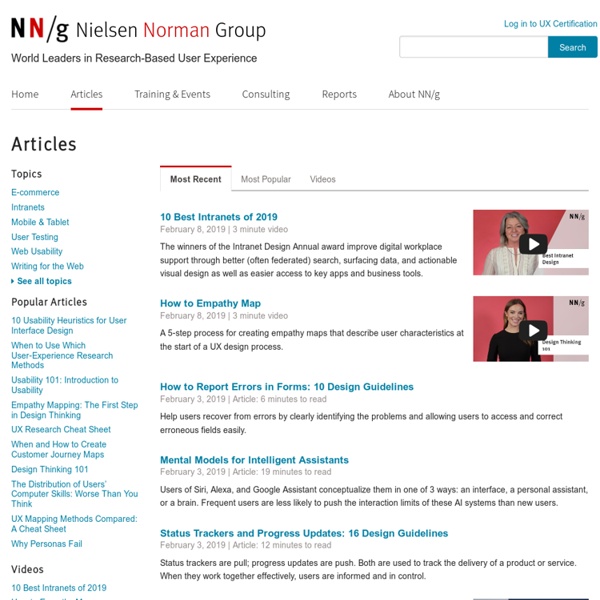



http://www.nngroup.com/articles/
10 Web Usability Tips - Just Fun 1. Motivate: Design your site to meet specific user needs and goals. Use motivators to draw different user "personae" into specific parts of your site. 2. White Paper Information Architecture Glossary Information Architecture Glossary By Kat Hagedorn, Argus Associates March 2000 This glossary is intended to foster development of a shared vocabulary within the new and rapidly evolving field of information architecture. Usability on the Web Usable Web sites are sites that work for your readers. A usable Web site encourages repeat visits. Find out what makes a usable Web site, and how to improve your own site. Learn how to do usability tests and create sites that your readers want to return to. What are Design PatternsDesign patterns are a useful tool to make sure that your site elements work as they are supposed to work.
Designing Web Pages that are Color-Blind Friendly Can you read the image that is displayed on this page? Are the colors correct for what the words say? If you're color blind, chances are you can't tell. According to most statistics, color blindness is a problem for 8 to 12% of males of European origin and about half a percent of females. Life With Alacrity: Tracing the Evolution of Social Software The term 'social software', which is now used to define software that supports group interaction, has only become relatively popular within the last two or more years. However, the core ideas of social software itself enjoy a much longer history, running back to Vannevar Bush's ideas about 'memex' in 1945, and traveling through terms such as Augmentation, Groupware, and CSCW in the 1960s, 70s, 80s, and 90s. By examining the many terms used to describe today's 'social software' we can also explore the origins of social software itself, and see how there exists a very real life cycle concerning the use of technical terminology.
Accessibility Validators - How to Use Accessibility Validators There are many HTML validators available to tell you if your HTML meets current standards or if it will look okay in a specific browser, but there is only one good validator that tells you if your page is accessible to people with disabilities: HiSoftware's CynthiaSays. Why Make Accessible Web Pages? Making your page accessible is more than just putting alt text on images (although that is a good start). But when you create accessible pages, you do more than just allow people with disabilities to use your site, you make your site easier for everyone. For example, alt text is a great way to provide more information about your images to everyone who comes to your site. When a reader puts their cursor over your image, some browsers will pop-up a description of the image - straight from your alt text.
Low Vision Web Page Layouts - Zoom Layouts Did you know that most people who are legally blind can actually see? If you're like me, you imagine that blindness is something like putting black goggles on, but for a lot of blind people, it is actually more like looking through waxed paper. In fact, one of my best friends is legally blind and she's a technical writer and she doesn't use a screen reader to write. Web Design - Web Design Basics - Web Development - Web Site Design When you're setting out to learn web design the first thing you should remember is that web design is very similar to print design in many ways. The basics are all the same. You need to understand space and layout, how to handle fonts and colors, and put it all together in a way that delivers your message effectively. The following articles will help you learn web design whether you are already a professional web developer or are just getting started learning web design.
Web Design Basics - Placement and Position - Elements of Design When you're starting a new design, no matter what your design methodology is, you start with a blank page. There is nothing on the Web page - so the first thing you'll do is put something up on the page. But do you think about the placement of those elements or do you just throw them onto the page willy nilly? Good designers don't allow the position and placement of their designs to occur randomly. They think about: what the element is how the element relates to the page goals where the element fits with the other elements on the page
Similar to Paper Layouts - Web Layouts Should be Simple and Clear When you create a Web design, one of the more overlooked aspects of the design is the layout. Now, many people think about how to do a layout (CSS, tables, frames, etc.), but the basics of Web layout are often completely ignored. Space and Whitespace Use the whole space, but don't be specific in your use.